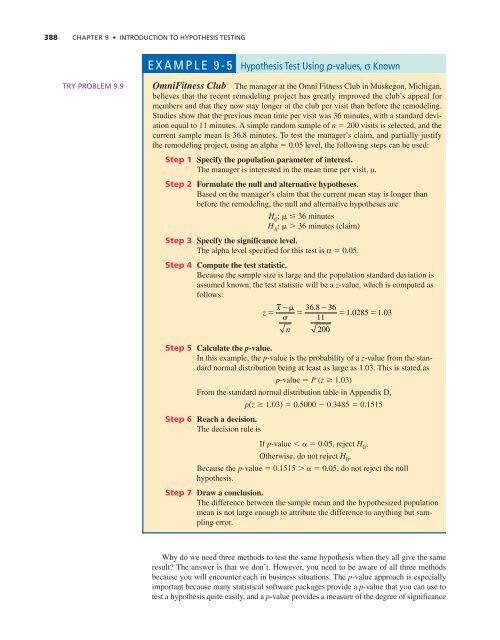Chapter 9: Introduction to Hypothesis Testing
Chapter 9: Introduction to Hypothesis Testing
Chapter 9: Introduction to Hypothesis Testing
Create successful ePaper yourself
Turn your PDF publications into a flip-book with our unique Google optimized e-Paper software.
388 CHAPTER 9 • INTRODUCTION TO HYPOTHESIS TESTING<br />
EXAMPLE 9-5<br />
<strong>Hypothesis</strong> Test Using p-values, σ Known<br />
TRY PROBLEM 9.9<br />
OmniFitness Club The manager at the Omni Fitness Club in Muskegon, Michigan,<br />
believes that the recent remodeling project has greatly improved the club’s appeal for<br />
members and that they now stay longer at the club per visit than before the remodeling.<br />
Studies show that the previous mean time per visit was 36 minutes, with a standard deviation<br />
equal <strong>to</strong> 11 minutes. A simple random sample of n 200 visits is selected, and the<br />
current sample mean is 36.8 minutes. To test the manager’s claim, and partially justify<br />
the remodeling project, using an alpha 0.05 level, the following steps can be used:<br />
Step 1 Specify the population parameter of interest.<br />
The manager is interested in the mean time per visit, μ.<br />
Step 2 Formulate the null and alternative hypotheses.<br />
Based on the manager’s claim that the current mean stay is longer than<br />
before the remodeling, the null and alternative hypotheses are<br />
H 0<br />
: 36 minutes<br />
H A<br />
: 36 minutes (claim)<br />
Step 3 Specify the significance level.<br />
The alpha level specified for this test is α 0.05.<br />
Step 4 Compute the test statistic.<br />
Because the sample size is large and the population standard deviation is<br />
assumed known, the test statistic will be a z-value, which is computed as<br />
follows:<br />
x<br />
z <br />
36.<br />
836<br />
1. 0285 1.<br />
03<br />
11<br />
n<br />
200<br />
Step 5 Calculate the p-value.<br />
In this example, the p-value is the probability of a z-value from the standard<br />
normal distribution being at least as large as 1.03. This is stated as<br />
p-value P (z 1.03)<br />
From the standard normal distribution table in Appendix D,<br />
p(z 1.03) 0.5000 0.3485 0.1515<br />
Step 6 Reach a decision.<br />
The decision rule is<br />
If p-value 0.05, reject H 0<br />
;<br />
Otherwise, do not reject H 0<br />
.<br />
Because the p-value 0.1515 0.05, do not reject the null<br />
hypothesis.<br />
Step 7 Draw a conclusion.<br />
The difference between the sample mean and the hypothesized population<br />
mean is not large enough <strong>to</strong> attribute the difference <strong>to</strong> anything but sampling<br />
error.<br />
Why do we need three methods <strong>to</strong> test the same hypothesis when they all give the same<br />
result? The answer is that we don’t. However, you need <strong>to</strong> be aware of all three methods<br />
because you will encounter each in business situations. The p-value approach is especially<br />
important because many statistical software packages provide a p-value that you can use <strong>to</strong><br />
test a hypothesis quite easily, and a p-value provides a measure of the degree of significance

















